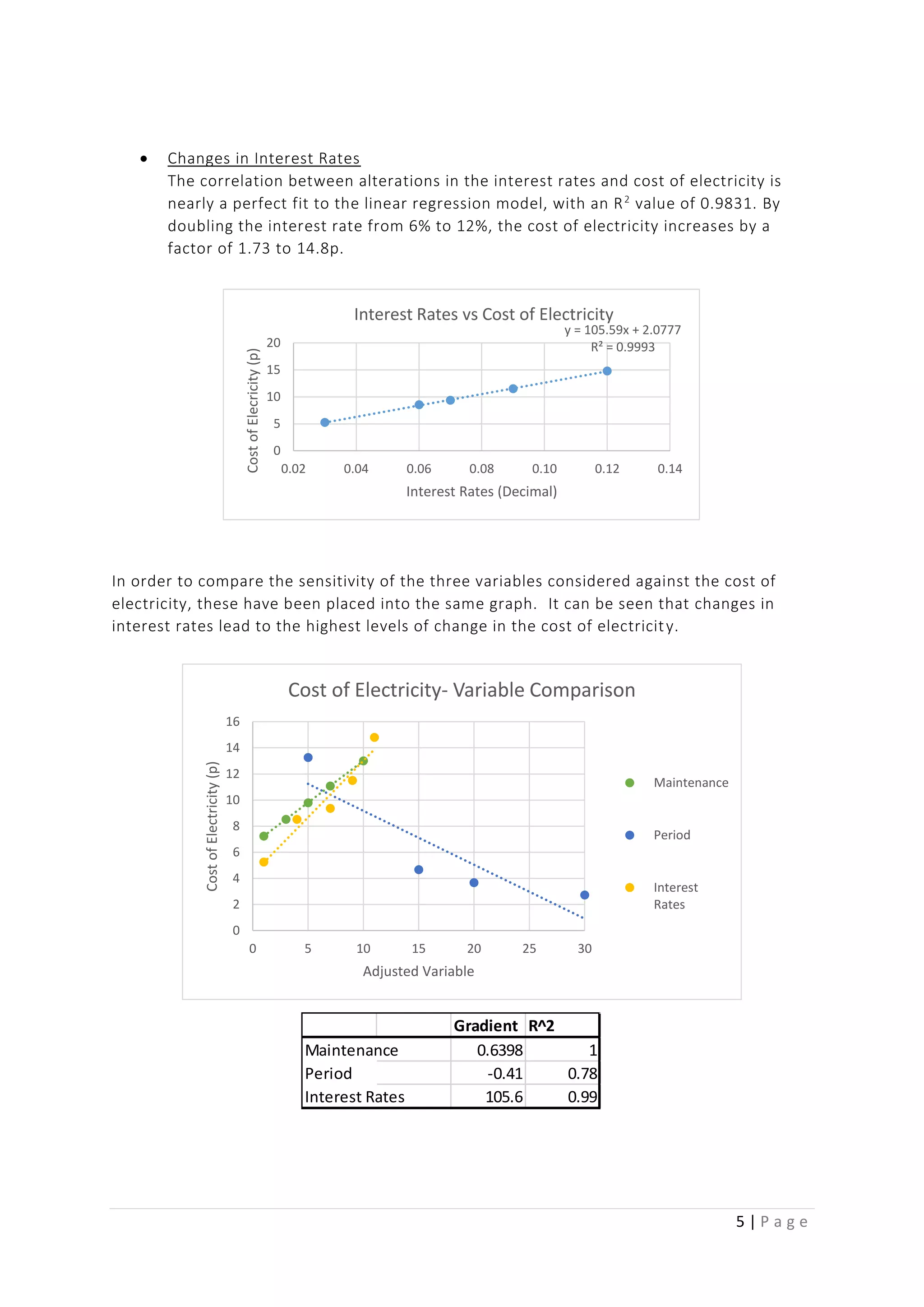1. The document analyzes the design calculations, cost of electricity, and sensitivity analysis for a proposed 1.9 MW offshore wind turbine. It finds the total annual energy output would be 3,204,093 kWh and the cost of electricity would be 8.4p per kWh.
2. It discusses potential environmental issues from constructing and operating offshore wind turbines, such as disrupting habitats and migration patterns of marine life. However, evidence also suggests turbines may create artificial reefs that increase biodiversity.
3. Social and economic factors could also impact development, as some object to reliability concerns or visual/navigational obstructions, though comprehensive assessments could mitigate negative impacts. The future of the technology
![1 | P a g e
Energy Resources & Policy Assignment 1: Wind Power
Gordon Best 201109204
Contents
Design Calculations........................................................................................................... 1
Cost of Electricity ............................................................................................................. 3
Sensitivity Analysis ........................................................................................................... 4
Environmental Issues ........................................................................................................ 6
Design Calculations
Calculate the Total Amount of Energy Captured in a Typical Year of Operation:
– Rated speed= 10+[0.2N], where N=2, =10.4m/s
– Cut In speed =4m/s
– Cut Out Speed= 24m/s
– Interest rate 6%
– 15 year operation
– 3% Maintenance Costs
– Full Area of turbine @ 94m diameter =6939.78m2
– ρ= 1.21
Cp= 0.42, so rated power @10.4m/s= 0.5 x 1.21 x 6939.78 x 10.43= 4.7MW
Theoretical rated power adjusted by Cp= 0.42 makes 1.9MW [RATED POWER]
CI= 0.26 MW x 0.42= 0.1MW
CO=58MW x 0.42= 24MW
Establish Number of Days for Ci, Co, and R operating speeds:𝑉∞ 𝑇0.5
= 60
T2= RATED =(
60
10.4
)2
= 33.29 days
T1= CUT IN= (
60
4
)2
=225 days
T3= CUT OUT= (
60
24
)2
=6.25 days](https://image.slidesharecdn.com/d7cc9e36-7eb4-490f-a354-a4ec840f2d66-160329154653/75/Energy-Resources-1-2048.jpg)
![2 | P a g e
Total Annual Output = Cp x 0.5 x ρA [ ∫ 𝑉3𝑇1
𝑇2
] + V3 R [T2-T3]
1st Component= 0.42 x 0.5 x 1.21 x 6939.78 [∫10.43 [
1
√𝑇
] 3 dt
=0.42 x 0.5 x 1.21 x 6939.78 x [
−2
√𝑇
]
225
33
(where integral solves to = -0.1333.. – 0.348..= 0.215= 215000)
=0.42 x 0.5 x 1.21 x 6939.78 x215000= 379130591.1
Multiply 379130591.1 by 0.21 days = 79947166.32 WDAYS [COMPONENT 1]
2nd Component= V3 R [T2-T3]
=0.42 x 0.5 x 1.21 x 6939.78 x 10.43 [33-6]
=1983583 x [27]
=53556742.03 WDAYS [COMPONENT 2]
Total Annual Output = Cp x 0.5 x ρA [ ∫ 𝑉3𝑇1
𝑇2
] + V3 R [T2-T3]
=79947166.32 + 53556742.03
=133,503,908.4 WDAYS
=133,503.9084 KWDAYS
Establish in kWh, so multiply by 24
=133,503,908.4 x 24= 3204093802= 3,204,093.9 kWh [TOTAL ANNUAL OUTPUT]
Mean Power Output=
133503
365
= 365.76kW [MEAN POWER OUTPUT]
Capacity Coefficient=
365.76
1900
= 0.19 [CAPACITY COEFFICIENT]](https://image.slidesharecdn.com/d7cc9e36-7eb4-490f-a354-a4ec840f2d66-160329154653/75/Energy-Resources-2-2048.jpg)
![3 | P a g e
Cost of Electricity
Annual payment =
Cr (1+r)^n
(1+𝑟) 𝑛−1
where N=15 years
Capital cost, C, is [2+0.025N] x106
= £2.050 x106
(£2.05million) [CAPITAL COST]
– Interest rate 6%
– 15 year operation
– 3% Maintenance Costs
– (1+r)n
= 2.4
Annual payment =
Cr (1+r)^n
(1+𝑟) 𝑛−1
=
2.05𝑥106 𝑥0.06 2.4
2.4−1
= £211,581 [ANNUAL PAYMENT]
Maintenance @3%= 0.03 x 2.05x106
= £61,500 [ANNUAL MAINTENANCE COST]
Total Cost Per Year= £211,581 + £61,500= £273,081 [TOTAL ANNUAL COST]
Total Cost (15 years) = £4,096,215
Cost of Energy=
Annual Cost of Project
𝐴𝑛𝑛𝑢𝑎𝑙 𝐸𝑛𝑒𝑟𝑔𝑦 𝑃𝑟𝑜𝑑𝑢𝑐𝑡𝑖𝑜𝑛
=
273081
3204093.9
= £0.084= 8.4p per kWh [ENERGY COST]](https://image.slidesharecdn.com/d7cc9e36-7eb4-490f-a354-a4ec840f2d66-160329154653/75/Energy-Resources-3-2048.jpg)



